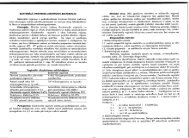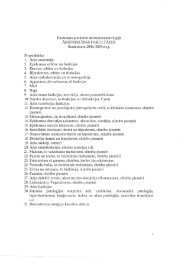PHYSICS
n - susliks.lv
n - susliks.lv
- No tags were found...
You also want an ePaper? Increase the reach of your titles
YUMPU automatically turns print PDFs into web optimized ePapers that Google loves.
(l05 N 2<br />
) · (0.6 ·W- 2 m ) . (0.12.10- 4 m 2)<br />
m<br />
(9.8 ~). (6 ·W- 2 m )<br />
c<br />
3.2.5. Work and Energy<br />
The work done by a constant force is defined as the product of<br />
the component of the force in the direction of the displacement<br />
and the magnitude of the displacement:<br />
A = F . s = (Fcos 8) s (3.15)<br />
where Fcosq is the component of F in the direction of S . Work<br />
is a scalar quantity and equation 3.15 is the scalar product of the<br />
two vectors F and s .<br />
The SI unit of work is the joule (J = N· m).<br />
The product of one half the mass (m) and the square of the<br />
speed (V) is defined as the kinetic energy of a particle:<br />
1<br />
E k: = -mV 2 (3.16)<br />
2<br />
Potential energy is accumulated in a system as a result of<br />
previous work being done.<br />
For instances, the gravitational potential energy near the<br />
Earth's surface is:<br />
E p<br />
= mgh (3.17)<br />
where m is the mass of the particle and h the displacement.<br />
The elastic potential energy, such as that stored in a spring, is:<br />
E p = '!"/a 2 (3.18)<br />
2<br />
where k is the force constant of the spring and x the displacement.<br />
Animal Extremes!<br />
The smallest bird is the bee hummingbird (Trochi/idae) <br />
1.6 g.<br />
3.3. CIRCULAR MOTION<br />
3.3.1. Kinematics of Rotational Motion<br />
If a particle of mass m is traveling in a circular path of radius r<br />
with a tangential velocity of V, the average angular velocity « to><br />
is the number of radians swept out by the radius in I second:<br />
!18<br />
=- (3.19)<br />
N<br />
where t18 = 8 - 2<br />
8 J<br />
equals the angular displacement.<br />
In analogy to linear velocity, the instantaneous angular velocity<br />
(w) is defined as the limit of the ratio in equation 3.19 as (M)<br />
approaches zero, or:<br />
. t:>e de<br />
w = lim -=- (3.20)<br />
~HO t:>t dt<br />
Angular velocity has units of rad/s or lis, since radians are<br />
not dimensional.<br />
The averaged angular acceleration «f3» of a rotating body is<br />
defined as the ratio of the change in the angular velocity to the<br />
time interval (M):<br />
t:> ta<br />
< f3 > = M (3.21)<br />
In analogy to linear acceleration, the instantaneous angular<br />
acceleration (f3) is defined as the limit of the ratio<br />
· t:>w doi<br />
f3 = 1Im--=- (3.22)<br />
M--.O t:>t dt<br />
Angular acceleration has units of radts' or Its'.<br />
The tangential velocity (V) of a point on a rotating rigid body<br />
equals the distance of that point from the axis multi plied by the<br />
angular velocity, or:<br />
V= rw. (3.23)<br />
The largest animal is blue wale (Belaenoptera musculus) _<br />
190 tons eS!!Jnated weight;<br />
24 25






